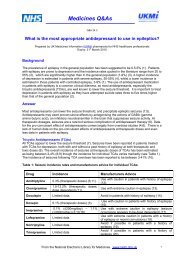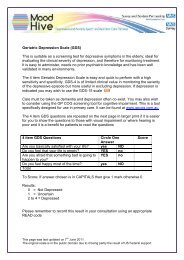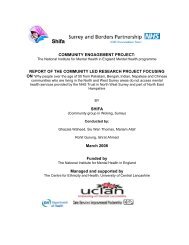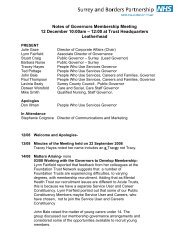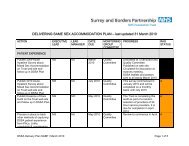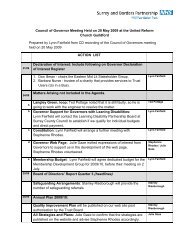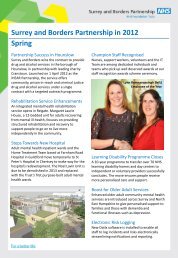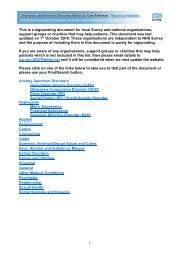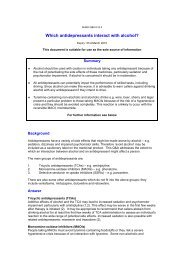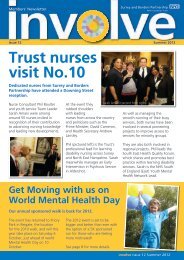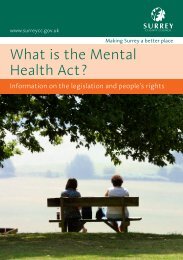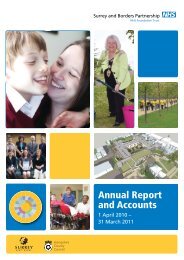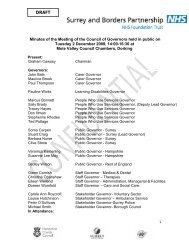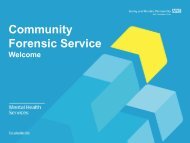Here - Surrey and Borders Partnership NHS Foundation Trust
Here - Surrey and Borders Partnership NHS Foundation Trust
Here - Surrey and Borders Partnership NHS Foundation Trust
You also want an ePaper? Increase the reach of your titles
YUMPU automatically turns print PDFs into web optimized ePapers that Google loves.
Research <strong>and</strong> Audit<br />
Discussion<br />
When considering the results of the initial<br />
audit, the numbers in several categories<br />
are too small to be of value when<br />
analysing the data by the different factors<br />
felt to be possible influences on the<br />
results. Results should be interpreted with<br />
this in mind. There was no clear variation<br />
of results by consultant or regularity of<br />
ward round. There does however appear<br />
to be a link between increasing length of<br />
stay <strong>and</strong> decreasing fulfillment of criteria.<br />
This may be due to becoming less aware<br />
of a patient’s risk the longer they stay <strong>and</strong><br />
an assumption that the risk is stable <strong>and</strong><br />
therefore the update is not completed as<br />
frequently <strong>and</strong> is more likely to be<br />
forgotten. The achievement of the<br />
recommended targets actually<br />
deteriorated when re-audited. This was<br />
mainly due to a reduction in completed<br />
risk assessments on admission <strong>and</strong> also a<br />
smaller percentage of risk assessments<br />
were updated regularly. There was also<br />
less evidence on re-auditing that length<br />
of stay impacted on achievement of<br />
recommended targets.<br />
Heightened awareness by e mail appears<br />
to have been ineffective therefore in<br />
improving st<strong>and</strong>ards. However, various<br />
factors could have impacted upon this.<br />
As a large number of junior doctors<br />
changed between the two data collection<br />
points, this could have affected the<br />
results as new doctors were less likely to<br />
have experience <strong>and</strong> remember to<br />
complete risk assessment forms than<br />
those who had been doing the job a few<br />
months. Also some notes would have<br />
been included in the data collection on<br />
both occasions, <strong>and</strong> this may have also<br />
altered results. Notes which had not met<br />
st<strong>and</strong>ards initially were unlikely to meet<br />
st<strong>and</strong>ards in the re-audit, which would<br />
have led to a disproportionately larger<br />
amount of notes not meeting st<strong>and</strong>ards<br />
in the re-audit compared to the initial<br />
audit. It was therefore beneficial to<br />
repeat the audit at a later stage towards<br />
the end of one group of junior doctors’<br />
employment (i.e. November/December<br />
2009). This allowed a long enough time<br />
period to ensure that no notes audited in<br />
earlier cycles are audited for a second<br />
time, which was a source of bias in the<br />
initial re-audit. This also allowed for<br />
consistency in documentation completion<br />
<strong>and</strong> had the advantage of identifying if<br />
time spent working in psychiatry helped<br />
increase awareness <strong>and</strong> completion of<br />
risk assessments <strong>and</strong> gave a more<br />
accurate picture of the benefit of any<br />
interventions that were implemented.<br />
Formal teaching on risk assessment was<br />
recommended during induction or in an<br />
early teaching session for this cohort of<br />
doctors as this has not been included in<br />
previous years. An improvement in<br />
meeting the recommened guidelines was<br />
evident from the re-audit in all areas, <strong>and</strong><br />
length of stay appeared to have less<br />
impact than in the previous cycles.<br />
It appears from the second re-audit that<br />
structured interventions <strong>and</strong> formal<br />
teaching that heighten awareness of the<br />
importance of risk assessment <strong>and</strong> how<br />
to complete the relevant paperwork have<br />
led to improvements in meeting the<br />
recommended guidelines. With the<br />
introduction to the ACU of the new<br />
computer system, RIO, such interventions<br />
will become all the more important in<br />
order to ensure risk continues to be<br />
documented to the highest st<strong>and</strong>ard. The<br />
overall outcome of this audit suggests<br />
that formal face to face teaching along<br />
with time spent working in psychiatry<br />
<strong>and</strong> heightened awareness on the ward<br />
of risk documentation are all necessary to<br />
optimise meeting the guidelines <strong>and</strong> such<br />
interventions should be regularly<br />
employed by the <strong>Trust</strong> for doctors, both<br />
at induction <strong>and</strong> throughout their<br />
rotation.<br />
20 <strong>Surrey</strong> <strong>and</strong> <strong>Borders</strong> Online Journal www.sabp.nhs.uk/journal



